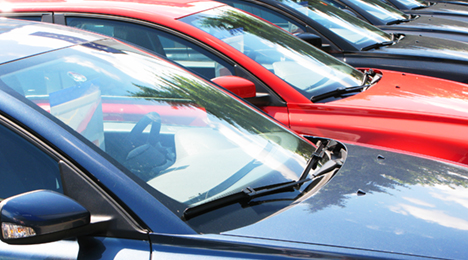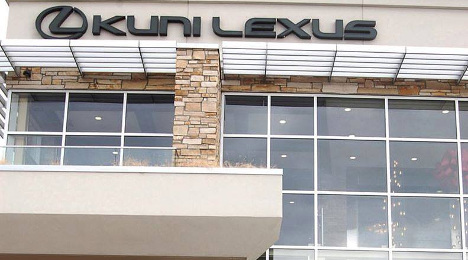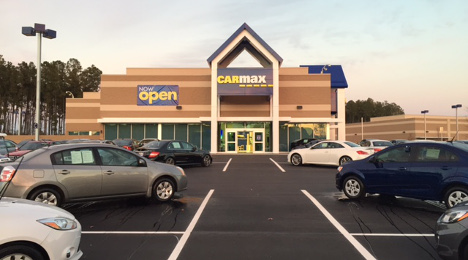More than just the recent decline in the Manheim Used Vehicle Index has Lithia Motors upbeat about supply availability, especially coming on the heels of double-digit gross profit rises within what dealer group executives classify as their core used-vehicle sales segment as well as their certified pre-owned division.
“We’re finally getting the cars that we need, and more importantly able to be more discerning in our choices of those cars to find the demand cars, which is where is where we build our gross profit,” Lithia president and chief executive officer Bryan DeBoer said last week when the company hosted its quarterly conference call and shared its first-quarter financial statement.
Perhaps what dragged Lithia’s overall used-vehicle gross down year-over-year was a softening of the performance within its value auto segment. These units are usually higher-mileage, older vehicles Lithia often turns with contracts associated with subprime buyers.
When touching on the supply of units that might fit within its value auto segment, DeBoer acknowledged, “It’s still tight. They’re still difficult to get.”
While the Manheim Index has dipped three months in a row, investment analysts wondered if that’s an automatic trigger for improved used-vehicle department performance.
“I think the softening of Manheim index is a positive thing that usually indicates that supply is loosening. I believe our stores are feeling that as well,” DeBoer said.
Lithia also remains steadfast in its goal toward achieving an average of 75 used-vehicle retail sales at each of its stores. The dealer group took another step toward that goal in Q1, climbing from 56 to 64, as Lithia turned a total of 26,531 used vehicles.
“I think we’ve seen some nice increases in a dozen stores or so,” DeBoer said. “We see more than ever that it’s people, inventory and the ability to attract the customers that are looking for those vehicles, and I think that will continue.”
Update on M&A activity
Wall Street observers again wanted to know if Lithia would continue to expand its store footprint, which stood at 138 dealerships when the first quarter closed.
Senior vice president and chief financial officer Chris Holzshu pointed out that Lithia has acquired eight stores during the past 12 months. “That’s the pace that I’m pretty confident that we can maintain,” Holzshu said.
Lithia remains hesitant when discussing if another acquisition to the scale of DCH Auto could be on its horizon. DeBoer didn’t mention the groups by name but perhaps referenced the deal that recently brought together Holman Automotive and Kuni Automotive.
“The acquisition market continues to build momentum; there is no question about it,” DeBoer said. “The prices are, however, pretty steep, and we are pretty disciplined on what our hurdle rates are on acquisitions.
“I think that we’ll see in the coming quarters and years opportunities still,” he continued. “I wouldn’t say that it’s going to slow, but I do think that we’re pretty picky. I mean again when we look at acquisitions, we look at approximately 10 to 15 acquisitions for every one that we’re able to buy.
“In terms of large groups, there is a lot of activity on those currently,” DeBoer went on to say. “I think many of you saw a large Northwest group that announced a couple of weeks ago. That was obviously … it appeared pretty pricey. It’s a wonderful group but it just doesn’t fit our (return on equity) thresholds when they are performing at a high level.”
Record F&I performance
Lithia established a new F&I department performance record during Q1 as gross profit per unit generated in the finance office came in at $1,290, representing a 9.5-percent rise year-over-year.
“As you know we've lagged our peer group for the last several quarters in F&I performance,” Holzshu said. “What we really focused on was three primary things. People and make sure we have the right people with the right pay plans. We have the right products and we have the right process. So we've been focusing on all three of those areas.
“We knew that we had the incremental opportunity there and we feel like right now we’re finally starting to see that execution happen and we feel confident that we can continue to do that for the remainder of the year,” he went on to say.
Enterprise Car Sales now has four locations in the nation’s third-largest metropolitan area.
The company announced last week that it has opened a store in Palatine, Ill., its fourth location in the Chicago area.
The store, which opened to the public in March, is a nearly 5,700-square-foot facility located on a three-acre lot. It can house more than 100 vehicles in inventory and has an Enterprise Rent-A-Car branch on site, as well.
“The steady growth we’ve witnessed in the Chicago region shows there’s clearly a high demand for quality used car-buying services in this market,” said Greg Tosch, sales manager in the Chicago area. “At Enterprise, we believe purchasing a car should be pleasant – not stressful.
“Our investment in the Palatine location allows us to offer even more Chicagoland customers the ease and convenience of a negotiation-free used car-buying experience.”
AutoNation retailed 58,103 used vehicles in the first quarter, down 0.9 percent from Q1 of 2015, according to the company’s earnings report released Friday.
Revenue per used unit retailed was $19,274, up 3.3 percent year-over-year. Gross profit per retail used vehicle, however, was down 7.7 percent at $1,613.
Looking at overall results, total revenue climbed 4 percent to $5.1 billion.
Earnings per share from continuing operations fell 7 percent to $0.90. This figure was negatively impacted by $0.03 per share in hail-related expenses and ”a shift of approximately $0.03 per share in stock-based compensation expense into the first quarter, due to a change from quarterly to annual stock option grants,” the company said in its release.
AutoNation chairman, chief executive officer and president Mike Jackson said in the news release: “As we stated last quarter, the market is in a plateau environment. Industry retail sales for the quarter were flat despite year over year manufacturer incentive increases of 14 percent, new-vehicle sales lease penetration over 30 percent, and high retail inventories. We still believe the industry will be above 17 million units for the year.”
Lithia Motors appears well on its way to hitting its annual projection of a 9.5-percent jump in used-vehicle sales thanks to the lift, especially in same-store performance, the dealer group posted during the first quarter.
Lithia reported this week that its Q1 used-vehicle retail same-store sales increased 12 percent year-over-year during a quarter that saw the dealer group generate the highest first-quarter adjusted net income in company history.
All told, Lithia stores turned 27,431 used vehicles in Q1, up 13.3 percent from the year-ago figure of 24,202 units.
Like many dealers are experiencing, too, Lithia watched its gross profit per used vehicle retailed drop again. The Q1 figure came in at $2,343, which was $113 lower than a year earlier.
Making up for it by a nearly identical figure was the extra gross per unit Lithia generated in F&I. The company put the Q1 F&I gross figure at $1,290; an amount $112 higher year-over-year.
On the new-car side, Lithia reported a 1.1-percent gain in gross profit to $2,039 as company stores turned 32,749 new models, representing a 6.9-percent jump compared to the first quarter of last year.
Along with the company record for Q1, Lithia reported that its adjusted net income climbed 9 percent year-over-year to $40.4 million, or $1.55 per diluted share.
Lithia’s Q1 total revenue rose $193.7 million, or 11 percent, to $2.0 billion, up from $1.8 billion.
“Our performance in the first quarter was solid,” Lithia president and chief executive officer Bryan DeBoer said. "We grew adjusted earnings per share 12 percent, drove double digit increases in both used retail vehicle and service, body and parts sales and set a record in F&I per unit. We also continued to increase revenue and profitability in our DCH stores.
“While national new-vehicle sales growth is moderating, we have significant opportunity to drive earnings growth through focus on growing vehicle market share and retaining service customers longer, improving store performance and targeting strategic acquisitions,” DeBoer added.
In Lithia’s news release sharing the Q1 financial report, senior vice president and chief financial officer Chris Holzshu touched on a couple of other areas of dealer group’s performance.
“Adjusted SG&A as a percentage of gross profit was 71.1 percent in the first quarter of 2016, an improvement of 20 basis points over the first quarter of 2015,” Holzshu said.
“In the first quarter, incremental throughput, or the percentage of additional same-store gross profit dollars that we retain after deducting incremental selling costs on a same-store basis, was estimated at 37 percent,” he continued. “Our stores generated strong increases in gross profit and will continue to focus on controlling advertising and personnel cost to improve operating leverage.”
Editor’s note: Watch for a report in an upcoming installment of Auto Remarketing Today recapping more details about Lithia’s operations and performance.
On Wednesday, CarMax highlighted a commitment to providing community support and career opportunities to the nation’s military, veterans and their families. CarMax and The CarMax Foundation have pledged a total of $1.4 million spread over the next three years to organizations supporting the military, including Hiring Our Heroes, KaBOOM and The Mission Continues.
CarMax joined the Philanthropy-Joining Forces Impact Pledge hosted by the Council on Foundations and Veterans Philanthropy Exchange in Washington, D.C. The organization represents an ongoing commitment to bring long-term support to service members, veterans and military families.
“Supporting the communities where our associates live and work has always been a cornerstone of the CarMax culture,” said Matt Aman, regional vice president of service operations of CarMax and former soldier in the U.S. Army Judge Advocate General's Corps.
“CarMax associates are passionate about supporting our military and as a veteran myself, I am proud to work for a company that supports this cause,” Aman continued.
CarMax pointed out that it employs veterans, active duty service members and military spouses in its stores and offices nationwide.
Through its partnership with Hiring Our Heroes, CarMax has joined the Veteran’s Employment Advisory Council and the Military Spouse Employment Advisory Council to help connect veterans, transitioning service members and military spouses to meaningful job opportunities. As part of the relationship, CarMax has committed $100,000 to support the efforts of Hiring Our Heroes.
“CarMax is actively recruiting men and women with military backgrounds because they share the same core values of integrity, respect, and honesty, and naturally make a great fit,” said Tracey Shoemaker, recruiting director for CarMax’s military program.
CarMax also is partnering with The Mission Continues, a national nonprofit that empowers veterans who are adjusting to life at home to find purpose through community impact. CarMax is committing $300,000 during the next two years that will include sponsoring service platoons. These teams of veteran and non-veteran volunteers mobilize together to solve specific challenges in their communities.
The CarMax Foundation also announced a $1 million partnership with KaBOOM to be the first corporate sponsor to bring play spaces to our military and veteran families.
The CarMax Foundation and KaBOOM, a national nonprofit organization dedicated to giving kids the childhood they deserve by bringing play to those who need it most, have successfully provided 100,000 children across the nation with access to play.
During the next three years, CarMax and KaBOOM will provide grants to fund four playgrounds and 30 play projects in military communities.
CarMax has partnered with a number of military bases across the country and respected military recruiting organizations such as GI Jobs and Recruit Military to connect the military community with CarMax job opportunities.
The company is proud to be recognized as one of FORTUNE’s 100 Best Companies to Work For, representing 12 years in a row. CarMax also received Victory Media’s Military Friendly Employer designation this eyar.
Job seekers can apply online at jobs.carmax.com.
As first reported by The Banks Report, Holman Automotive announced on Tuesday that it will acquire Kuni Automotive in a deal that executive say creates one of the largest privately owned dealer networks in the country.
Holman added the deal also ensures a long future for a major charitable foundation.
The dealer group highlighted the acquisition, expected to be finalized this summer, will create a bi-coastal network with 33 dealerships and more than $3 billion in overall annual revenue, doubling Holman Automotive’s retail holdings.
Holman currently has dealerships in New Jersey, Pennsylvania and Florida. Kuni Automotive, with dealerships in Washington, Oregon, California, Colorado and Kansas, will maintain its brand name and will be known as Kuni Automotive, a Holman Enterprise.
Executives added that the terms of the deal will not be disclosed.
As a result of this deal, the majority shareholder in Kuni Automotive — the Wayne D. Kuni and Joan E. Kuni Foundation — a charitable foundation that has supported cancer research and worked to enhance the lives of developmentally disabled adults since 2005, will be able to fund its work well into the future.
Additionally, the foundation expects to be able to broaden the scope and geography of its charitable outreach.
“Our two companies share a deep culture of charity and community service," said Melinda Holman, chairman of the board of Holman, who will join the board of the Kuni Foundation.
“Knowing that more than half of the proceeds will go to the Kuni Foundation and serve people in need for decades to come is a wonderful byproduct of this transaction,” Holman continued.
The dealer groups said that it was vital to Kuni Automotive chief executive officer Greg Goodwin to find a buyer who not only shares his company's values, but would also create a company that is not just bigger, but better.
“We are creating a company that is greater than the sum of its parts," said Goodwin, who will remain with the company in a leadership position.
“It's easy to get lost in the ‘bigness’ of this transaction, but ‘big’ doesn't serve a purpose if it doesn't improve the company,” Goodwin added.
Holman executive vice president and chief strategy officer William Cariss has been responsible for overseeing the Holman-Kuni transaction from start to finish. Once the transaction is complete, Cariss will be responsible for identifying future investment opportunities across Holman’s business segments.
“As we consider future opportunities, we hope to find companies, like we did with Kuni, that have similar values and work ethics that blend well with the Holman culture,” Cariss said.
Holman CEO Carl Ortell pointed out the expansion comes at a time of consolidation and innovation in the automotive industry.
“Our acquisition of Kuni comes at a time when these two organizations have never been stronger. We are well-positioned to remain a leader in the auto industry as it continues to evolve. What's more, we are well-placed for future growth in all of Holman's business segments,” Ortell said.
“We’re creating a company with a global footprint that will allow our people to explore new career opportunities within the larger organization,” he went on to say.
Holman plans to remain a privately owned company in anticipation it “continues to grow and flourish.”
Melinda Holman added, “Plan A is to remain a family-owned company for generations to come. And there is no Plan B.”
CarMax hosted its quarterly conference call to share results of its 2016 fiscal year on the same day that Cox Automotive chief economist Tom Webb conducted his regular phone gathering to discuss a wide array of industry topics.
It just so happened that call participants asked Webb about how CarMax manages to keep its used-vehicle margins strong while investment analysts also questioned CarMax chief executive officer Tom Folliard about how the declining Manheim Used Vehicle Value Index would impact performance of the dealership chain.
As he often does, Webb’s presentation before taking questions included a slide where he tracked the retail gross margin on used vehicles generated by the seven publicly traded dealership groups, which includes CarMax. Webb’s latest information put the sales-weighted average at a level near 8.5 percent, stemming from a streak of declines covering seven of the past eight quarters.
An investment observer wondered if the latest drop from a recent high above 11.5 percent spotted in 2009 might be even more dramatic if CarMax’s performance was taken out of the analysis. CarMax reported at the close of its 2016 fiscal year that gross profit per unit sold came in at $2,159, down by $20 a year earlier.
Just for comparison, AutoNation closed 2015 with a 6.7-percent drop in used-vehicle gross profit as the reported figure was $1,577. Over at Sonic Automotive, the company indicated its used-vehicle gross slipped 3.1 percent year-over-year to come in at $1,384 in 2015.
To explain CarMax’s performance, Webb said, “In fourth quarter of last year where same store sales went down, that was a reflective of the fact that they wanted to hold gross.”
Webb reiterated that his analysis “is sales-weighted and (CarMax has) the volume. It would look worse if you pulled out the other six.”
So why are the other six dealer groups so different from CarMax in terms of used-vehicle margins?
Webb said, “Their philosophy is to a certain extent give away the razor to sell the blade because they’re putting vehicles in operation and hoping for very high margins on the service side.”
Earlier in the morning when CarMax conducted its call, Folliard explained how the company can keep its margins much higher than the rest of the industry.
“It’s an overall inventory management process for us, and it starts with the by having the right car in the right place at the right time,” Folliard said. “That allows us to be able to deliver an exceptional value to the customer.”
Folliard also noted CarMax sometimes avoids inventory pieces that are what company personnel might think are “a little expensive.” During the previous quarter of CarMax’s fiscal year, a segment that fell into that description was full-size SUVs, “so we didn’t buy as many and that allows us to manage our margin.”
The CarMax boss also mentioned how the company transfers vehicles within its dealership network depending on buyer requests. That process happens during about a third of its retail sales, according to Folliard.
“That allows us to turn our inventory quickly,” he said. “I think our turns help us manage our margins pretty well.”
And if CarMax spots a trends where a particular model or segment rises in demand? Folliard explained how the company can evaluate margin variability.
“We are big enough now that we can test pockets and markets and different types of product all across the country and learn a lot about price elasticity,” Folliard said. “And then that’s reflected in the ultimate margins that we achieve and the sales that we get.
“I am very pleased with the quarter and with the results and a positive comp based on one of our tougher comparisons last year,” he continued. “And yes, I think we can get better at this as time goes along. I think we are better at managing our inventory and our margins than we were a few years ago.
“And with continued use of external and internal data and training and development of the process, I think we will just continue to get better at it. So I am pretty pleased with the progress that we have made and the results we have been able to deliver,” Folliard went on to say.
Later in CarMax’s call, the topic of margins returned. But this time, it was in connection with the Manheim Index, which now has dropped for three consecutive quarters. An industry observer wanted to know if CarMax’s retail margins could move even higher if wholesale vehicle prices continue to soften.
“When the Manheim Index goes down and we can buy cars cheaper, we want to give our customers a better deal,” Folliard said. “We have chosen whether it’s right or wrong to not increase our margins when our prices go down because we want to give our customers a better deal.
“We are building our business over a very, very long period of time,” he continued. “We want (customers) to leave and say, ‘Why I got a really fantastic deal. The next time I buy a car, I want to buy it from CarMax.’”
“You can argue with our motives but when our ability to buy a car is cheaper, we have chosen to pass those savings onto our customers as opposed to taking it into margin. That’s just what we have done,” Folliard went on to say.
The CarMax CEO pointed to how the company performed during the last recession.
“Our average retail price dropped by over $2,000 in three months and we kept our margins and we bought cars cheaper over that period of time by that same amount and we chose to keep our margins flat,” Folliard said. “That’s just the decision that we made.
“I think we gave a whole bunch of customers a great deal and hopefully made customers for life,” he continued. “That’s how we have chosen to run our business. It doesn’t mean that we will do it exactly that way going forward. But when we have the ability to buy cars cheaper, we pass those savings onto our customers.”
CarMax reported this week that its total used unit sales rose 4.0 percent in the fourth quarter and 6.5 percent during its fiscal year that finished on Feb. 29.
The company’s network of 158 stores in 78 markets turned a total of 619,936 vehicles during the 2016 fiscal year, up from 582,282 units a year earlier.
Of that fiscal year figure, CarMax retailed 155,237 vehicles during Q4.
The company’s wholesale vehicle endeavors also posted gains. CarMax reported that it wholesaled 394,437 units during the 2016 fiscal year. That’s up by 4.9 percent versus the year-ago figure of 376,186 units.
The retail and wholesale divisions pushed CarMax to a 6.2-percent climb in net sales and operating revenues to $15.15 billion. As a result, the company’s net earnings increased 4.4 percent to $623.4 million and net earnings per diluted share rose 11.0 percent to $3.03.
CarMax noted year-over-year comparisons in net earnings were affected by a previously announced receipt of proceeds in a class action lawsuit in the second quarter of the prior fiscal year, which increased earnings by $12.9 million, net of tax, or $0.06 per diluted share.
The company reported that total gross profit in Q4 increased 2.8 percent versus last year’s fourth quarter to $489.3 million. CarMax also mentioned used-vehicle gross profit rose 2.1 percent, driven by that previously mentioned 4.0 percent increase in total used unit sales.
However, CarMax acknowledged that Q4 used vehicle gross profit per unit declined to $2,109 compared with $2,148 in the corresponding prior-year period. The company pointed out Q4 wholesale vehicle gross profit also dipped, ticking down by 0.7 percent year-over-year. The company also noted the 2.3-percent jump in wholesale vehicle unit sales was offset by a decrease in wholesale vehicle gross profit per unit to $1,005 from $1,036.
CarMax added other gross profit rose 11.9 percent, primarily reflecting the improvements in EPP revenues and net third-party finance fees.
The company also shared the performance of its captive, CarMax Auto Finance.
Compared with last year’s fourth quarter, CarMax Auto Finance Q4 income rose 2.2 percent to $92.3 million, driven by an increase in average managed receivables, which was largely offset by a lower total interest margin percentage and an increase in the provision for loan losses.
The finance company’s average managed receivables grew 13.9 percent to $9.45 billion. Executives explained the total interest margin — which reflects the spread between interest and fees charged to consumers and their funding costs — declined to 5.9 percent of average managed receivables from 6.3 percent in last year’s fourth quarter.
“The increase in the provision for loan losses reflects the growth in our managed receivables and favorable loss experience in last year’s fourth quarter, which reduced the prior year provision,” CarMax executives said, who added that their allowance for loan losses as a percentage of ending managed receivables remained similar at 0.99 percent as of the end of the 2016 fiscal year.
Also of note for the fourth quarter, CarMax opened five stores, including three stores in new markets. Two were located in Boston and one in Peoria, Ill. Two others came aboard in existing markets — the company’s sixth store in Atlanta and third store in St. Louis.
In total, CarMax opened 14 stores and relocated one store during the 2016 fiscal year.
“While we faced a somewhat more challenging sales environment in the second half of the year, we delivered solid revenue and EPS growth in both the fourth quarter and the fiscal year, we opened a record number of stores and we made progress toward optimizing our capital structure by buying back 16.3 million shares in fiscal 2016,” CarMax chief executive officer Tom Folliard said.
The unintended consequence.
That’s what Jeff Carlson, the 2016 chairman of the National Automobile Dealers Association, said NADA is trying to prevent through its policy work in Washington, D.C.
The Colorado Ford and Subaru dealer said many of the federal government’s regulatory and policy moves related to the car business have good intentions, but could end up hurting consumers.
This plank of NADA’s platform was part of a wide-ranging emailed Q&A between Carlson and Auto Remarketing three weeks prior to the dealer association’s annual convention.
“NADA’s policy engagement efforts all have a common theme — and that’s protecting consumers from the unintended consequences coming out of Washington, D.C., and informing other key stakeholders about the tried-and-true benefits of the dealer franchise system,” Carlson said when asked about NADA’s goals and focus for 2016.
“A major focus of NADA continues to be encouraging dealers to adopt the NADA/NAMAD/AIADA Fair Credit Compliance Program as the best way to address the issue of fair credit risk in auto financing,” he said.
“This voluntary compliance program was structured to reflect a program by the U.S. Department of Justice that fully addresses fair credit risk in auto lending, while preserving the dealer discounts that are the hallmark of competition and consumer savings in the marketplace,” Carlson said.
(More on Carlson’s chairmanship goals below)
Policymaking and regulatory issues were also a key point when Carlson addressed the biggest hurdles for dealers. Auto Remarketing asked him what he sees as the biggest challenges for franchised dealers in 2016, and how these might be used as opportunities.
“There are many federal regulatory issues today that could hurt our customers with higher costs. Whether it’s eliminating competition in the auto finance market or enacting an overly broad and counterproductive recall policy, there are a number of ideas emanating out of Washington, D.C. that, while well-intentioned, could result in negative unintended consequences,” Carlson said. “In these areas, NADA is working hard to protect consumer rights, consumer choice and consumer savings.
“Vehicle affordability must be a bedrock principle for national policymakers. Affordability expands consumer choice and drives consumer acceptance,” he said. “Consumer acceptance drives fleet turnover. And fleet turnover achieves the desired results of economic growth, improved fuel efficiency and safer vehicles on our roadways that we all want.”
What’s needed to fix recall process
Going back to one of Carlson’s policy points — that of vehicle recalls — it’s safe to say the auto industry has never seen anything like the current recall environment. Citing data from the National Highway Traffic Safety Administration, Carfax said in a recent analysis that more than 51 million recalls were issued in 2015, more than any year prior.
The same bit of analysis from Carfax, released in February and reported on by Auto Remarketing, says there were over 47 million vehicles in the United States that had at least one unrepaired safety recall, at the time of the report.
Numerous parties, be they government- or auto industry-based, have received criticism related to recalls, whether it’s their timeliness, execution or otherwise.
Suffice to say, the actual process and logistics behind the reporting, fixing and adjusting to recalls has arguably had its challenges.
Some, like AutoNation, have responded by not selling any vehicle under an open safety recall.
We asked Carlson what NADA plans to do to help make the recall process smoother for dealers.
“The nation’s franchised new-car dealers are the solution to completing safety recalls, and fully support achieving a 100-percent recall-completion rate. But we all have to remember that not every recall presents the same level of urgency to the driving public,” Carlson said.
“In fact, the vast majority of recalls are for minor compliance issues that present virtually no imminent safety risk to the driver, passenger or other drivers,” he said.
“So, why is it counterproductive from a safety standpoint to treat all recalls the same? Because studies show that prohibiting the sale of any used vehicle subject to any open recall, including the most minor of recalls, could drive down the value of trade-ins by literally thousands of dollars,” he said.
“And if we devalue trade-ins, we automatically give consumers an economic incentive to turn to private market sales, where evidence clearly shows that the recall completion rates plummet. Plus, when a consumer’s trade-in is devaluated, it becomes more expensive for that consumer to purchase a newer, safer car.
“So rather than adopting an overly broad recall policy that would be harmful to consumers and detrimental to goal of fixing recalls, a far better approach would be creating a system that properly differentiates truly dangerous recalls from minor ones,” Carlson said. “Dealers also support data-driven policies that empower consumers, including NHTSA’s public awareness campaign aimed at reminding cars owners that they may have a safety recall.”
Additional NADA goals
Beyond policy and regulatory issues, Carlson said NADA aims to continue giving dealers the training tools they need — through programs at NADA Academy, NADA University Online, NADA 20 Group and its annual convention — to adapt to changes in the car business.
NADA is also aiming to bring younger generations of dealers and dealership managers into the “grassroots legislative advocacy” process with their respective dealer associations.
For additional coverage of the NADA Convention & Expo, see Auto Remarketing's Special Convention Issue.
Along with authorizing a share repurchase on Thursday, Lithia Motors’ board of directors appointed a new member who officially came into the fold this week.
Joining the dealer group’s leadership team is David Robino, who will serve as an independent director.
Robino began his management career with Maytag and at Pepsi-Cola and worked as senior vice president of Nielsen International where he led multiple global business functions. Robino also served as vice president of AT&T Solutions and later at AT&T's Business Markets Division, and at Gateway as executive vice president, chief administrative officer and vice chairman.
Robino also has previously served on the boards of Memec and Insight Enterprises. He has a master’s degree from Iowa State University and bachelor’s degree from Graceland College.
“We are pleased to have David join our board of directors,” Lithia chairman Sid DeBoer said. “We look forward to the experience and insight that he will bring.”
Robino replaced William Young, who retired from Lithia’s board of directors effective Tuesday.
“Bill served as a member of our board since 2010, and we thank him for his years of valuable service,” DeBoer said.
Also, the company’s board authorized the repurchase of up to $250 million of Lithia Class A common stock. This decision modified the existing authorization, increasing the total and establishing a maximum dollar rather than share amount.
Lithia had approximately 26 million shares of Class A common stock outstanding as of Tuesday.
CEO completes Morrie's Automotive Group acquisition
In other dealer group news released this week, Fremont Private Holdings and Karl Schmidt announced that they have completed the acquisition of Morrie's Automotive Group, which includes 11 dealership locations. FPH, Schmidt and management acquired the group from Morrie Wagener and the Wagener family.
Morrie’s will continue to be led by Schmidt, chief executive officer of the group based in Minnetonka, Minn.
“FPH is the perfect partner for our business. We share the same vision for the company, and FPH brings a strong knowledge of the industry as well as access to the capital and resources necessary to enable us to continue to improve our offerings and better serve our customers,” Schmidt said.
The acquisition process was first announced last fall.
“We look forward to our partnership with Karl and his team, who created the Buy Happy promise and have led Morrie's to where it is today,” FPH managing partner Scott Earthy said. “The company is one of the leading dealership groups in the Twin Cities area. We are excited about the opportunity we have to enhance our operations and expand in the Upper Midwest region over time."
FPH partner Tim Sheehy added, “Morrie’s exemplifies everything we look for in an investment — an attractive, unique service offering, a proven and dedicated team, and a demonstrated history of success. We look forward to working closely with Karl and the management team to achieve our strategic goals.”












